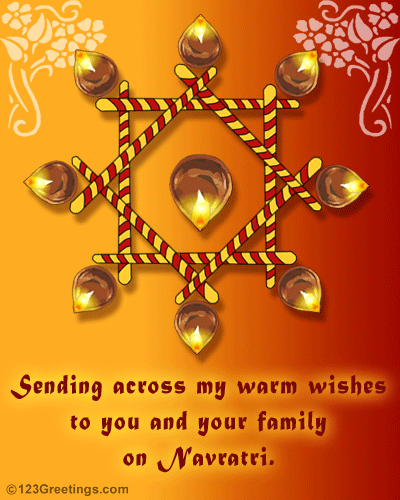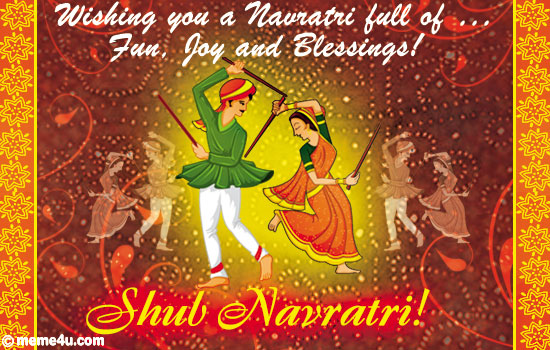
Significance😳
The beginning of spring and the beginning of autumn are considered to be important junctions of climatic and solar influences. These two periods are taken as sacred opportunities for the worship of the Divine Mother Durga. The dates of the festival are determined according to the lunar calendar.
Navarathri represents a celebration of the Goddess Amba, (the or Power). The Navarathri festival or "Nine Nights festival"
Worship of The Divine as Mother is a special characteristic of the Indian Culture. God is mostly referred as the Father of all creation or the Omnipotent ruler of Nature in other religions. Navaratri or Navadurga Parva happens to be the most auspicious and unique period of devotional sadhanas and worship of Shakti (the sublime, ultimate, absolute creative energy of the Divine conceptualized as the Mother Goddess-Durga, whose worship dates back to prehistoric times before the dawn of Vedic age.
A whole chapter in the tenth mandal of the holy Rigveda deals with the devotional sadhanas of Shakti. The "Devi Sukta" and "Usha Sukta" of the Rigveda and "Ratri Sukta" of the Samveda similarly sing paeans of praise of sadhanas of Shakti.
Before the beginning of the Mahabharat war, Lord Krishna had worshipped Durga - the Goddess of Shakti- for the victory of the Pandvas.
Lord Brahma is cited in the Markandey Purana as mentioning to Rishi Markandey that the first incarnation of Shakti was as Shailputri. Other incarnations of the Divine Mother are: Brahmchari, Chandraghanta, Kushmanda, Skandamata, Katyayani, Kalratri, Mahagauri and Siddhidatri in that order. These nine manifestations of Shakti, are worshipped as "Nava-Durga". The fifth chapter of the Rudra Sanhita of Shiva Purana also vividly describes the various Divine Emanations of Durga.
Since the Vedic Age of the Rishis, the devotional practices recommended during Navratri are primarily those of Gayatri Anushthana.
In the Vedic Age of the Indian Culture, the religious philosophy and devotional practices were focused towards true knowledge and ultimate realization of the supreme power of Gayatri (Bram Shakti). The Vedas were the basis of all streams of spirituality and science those days. Gayatri has been the source of the divine powers of the gods in the heavens and their angelic manifestations and incarnations. Gayatri sadhana was also paramount in the higher level spiritual endeavors of the yogis and tapaswis. Gayatri Mantra was the core-focus of daily practice of sandhya-vandan (meditation and devotional worship) for everyone. As guided by the rishis, specific sadhanas and upasanas of the Gayatri Mantra were sincerely practiced during the festival period of Navaratri by every aspirant of spiritual enlightenment.
Traditions Of Navarthri😳
Navaratri is celebrated five times a year. They are Vasanta Navaratri, Ashadha Navaratri, the Sharad Navaratri, and the Paush/Magha Navaratri. Of these, the Sharad Navaratri of the month of Puratashi and the Vasanta Navaratri of the Vasanta kala are the most important.
2. Gupta Navaratri: Gupta Navaratri, also referred as Ashadha or Gayatri or Shakambhari Navaratri, is nine days dedicated to the nine forms of Shakti (Mother Goddess) in the month of Ashadha (June-July). Gupta Navaratri is observed during the Ashadha Shukla Paksha (waxing phase of moon).
3. Sharad Navaratri: This is the most important of the Navaratris. It is simply called Maha Navaratri (the Great Navratri) and is celebrated in the 'pratipada' (first day) of the bright fortnight of the lunar month of Ashvina. Also known as Sharad Navaratri, as it is celebrated during Sharad (beginning of winter, September-October).
4. Paush Navaratri: Paush Navaratri is nine days dedicated to the nine forms of Shakti (Mother Goddess) in the month of Paush (December-January). Paush Navaratri is observed during the Paush Shukla Paksha (waxing phase of moon).
5. Magha Navaratri: Magha Navaratri, also referred as Gupta Navaratri, is nine days dedicated to the nine forms of Shakti (Mother Goddess) in the month of Magha (January-February). Magha Navaratri is observed during the Magha Shukla Paksha (waxing phase of moon).

Rituals😳
First three days
The goddess is separated a spiritual force called Durga also known as Kali in order to destroy all our evil and grant boons.
Second three days
The Mother is adored as a giver of spiritual wealth, Lakshmi, who is considered to have the power of bestowing on her devotees inexhaustible wealth, as she is the goddess of wealth.
Final three days
The final set of three days is spent in worshiping the goddess of wisdom, Saraswati. In order to have all-round success in life, believers seek the blessings of all three aspects of the divine femininity, hence the nine nights of worship.See also: Kanya Puja
Eighth day is traditionally Durgashtami which is big in Bengal and Bihar
In some parts of South India, Saraswati puja is performed on the 9th day. Ayudha Puja is conducted in many parts of South India on the Mahanavami (Ninth) day with much fanfare. Weapons, agricultural implements, all kinds of tools, equipments, machinery and automobiles are decorated and worshipped on this day along with the worship of Goddess. The work starts afresh from the next day, i.e. the 10th day which is celebrated as 'Vijaya Dashami'. Many teachers/Schools in south India start teaching Kindergarten children from that day onwards.
In North India, as the culmination of the Ramlila which is enacted ceremoniously during Dussehra, the effigies of Ravana, Kumbhakarna, and Meghanada are burnt to celebrate the victory of good (Rama) over evil forces on the 'Vijaya Dashami' day.
During Navratri, some devotees of Durga observe a fast and prayers are offered for the protection of health and prosperity. Devotees avoid meat, alcoholic drinks, grains, wheat and onion during this fast. Grains are usually avoided since it is believed that during the period of Navratri and seasonal change, grains attract and absorb lots of negative energies[6] from the surrounding and therefore there is a need to avoid eating anything which are produced from grains for the purification of Navratri to be successful. Navratri is also a period of introspection and purification, and is traditionally an auspicious and religious time for starting new ventures.
During this vowed religious observance, a pot is installed (ghatasthapana) at a sanctified place at home. A lamp is kept lit in the pot for nine days. The pot symbolises the universe. The uninterrupted lit lamp is the medium through which we worship the effulgent Adishakti, i.e. Sree Durgadevi. During Navratri, the principle of Sree Durgadevi is more active in the atmosphere.
Navratri is celebrated in a large number of Indian communities. The mother goddess is said to appear in 9 forms, and each one is worshiped for a day. These nine forms signify various traits that the goddess influences us with. The Devi Mahatmya and other texts invoking the Goddess who vanquished demons are cited.
During the eight or ninth day, Kanya Poojan, pre-pubescent girls are ceremonially worshipped.



































